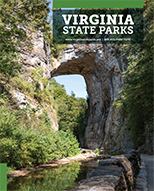Read Our Blogs
Grayson Highlands State Park: A unique mountain ecosystem

The view from Little Pinnacle, the highest peak in the park
Have you heard of Southern Appalachia’s sky islands? These high-elevation habitats are located atop isolated mountain ranges and include the Great Smoky Mountains, Plott Balsams, Great Balsams, Black Mountains, Unaka Mountains, Roan Mountain and Grandfather Mountain and Mount Rogers/Highlands of Virginia.
So, this means when you go to Grayson Highlands State Park, you’re going to experience this unique and fragile mountaintop ecosystem.
Grayson Highlands is the highest state park in Virginia, with elevations topping 5,089 feet. This altitude creates an environment more like what you’d find hundreds of miles north in New England than what’s typical of the southern Appalachians.
Cool summers, frequent fog and harsh winters shape the plant and animal communities that call the park home. Keep reading to learn more.
Alpine-like balds

A portion of balds at Grayson Highlands State Park
One of the park’s most distinctive features is its high-elevation balds, open, grassy meadows dotted with wildflowers and shrubs. These windswept areas provide habitat for species not commonly found in Virginia, including rare grasses and flowering plants that thrive in cool, open conditions. They also offer visitors breathtaking views of Mount Rogers, the highest peak in Virginia, and the Blue Ridge Mountains.
Forest diversity

Spruce cones at Grayson Highlands
Below the balds, Grayson Highlands transitions into dense forests of red spruce, Fraser fir and northern hardwoods, which are trees more typical of climates further north. These woodlands support a range of wildlife, from black bears and bobcats to native brook trout and salamanders. Birdwatchers might catch a glimpse of species that prefer higher elevations, such as the red crossbill. The mixture of forest and open meadow creates a variety of habitats that sustain remarkable biodiversity.
Why it’s special
Grayson Highlands State Park is special because it preserves a part of mountain ecology that is both rare and fragile in Virginia. Its high elevation, alpine-like balds, diverse forests and abundance of unique wildlife make it a living classroom.
Protecting this ecosystem ensures that future generations can experience what makes Grayson Highlands so extraordinary.
Visiting Grayson Highlands State Park

Winter at Grayson Highlands can be harsh
The features that make Grayson Highlands special also mean visitors should plan carefully for a safe trip. Here are a few tips:
- Prepare for changing weather: Temperatures at 5,000 feet can be much cooler than in the valleys below, and storms can move in quickly. Dress in layers and bring rain gear, even on sunny days.
- Respect the ponies: Feral ponies can be found in some areas of the park. They are beautiful to watch but remember they are not tame. Feeding or approaching them is unsafe for both you and the ponies. Enjoy them and take photos from a distance.
- Watch your footing: Many trails are rocky and uneven. Good hiking boots and trekking poles can help you navigate safely.
- Stay on designated trails: To protect the fragile high-elevation ecosystem, and to avoid getting lost, stick to marked paths.
- Pack the essentials: Carry water, snacks, a map and a flashlight. Cell service can be spotty, so don’t rely solely on your phone for navigation. We recommend downloading the park map from Avenza before your visit. Having this PDF map on your phone will allow you to see your exact location on a trail even if you don’t have cell phone service. Learn more at https://dcr.am.virginia.gov/state-parks/park-trail-maps.
To learn more about Grayson Highlands State Park and to start planning your visit, go to https://dcr.am.virginia.gov/state-parks/grayson-highlands.
If you have read the article and have a question, please email nancy.heltman@dcr.virginia.gov.
Search for blogs
By Park
Categories
Cabins
Camping
Fishing
History and Culture
Other
Programs and Events
Trails
Volunteers
Water Fun
Archive
2025
2024
2023
2022
2021
2020
2019
2018
2017
2016
2015
2014
2012













